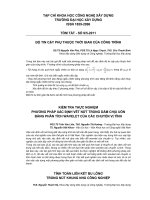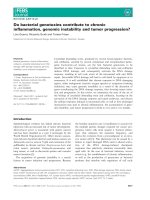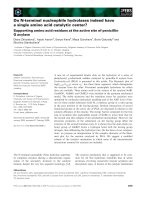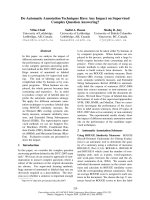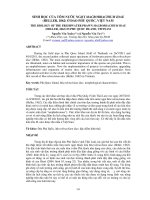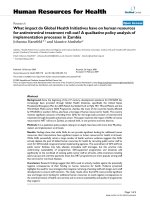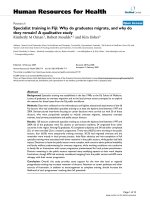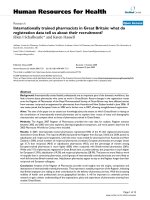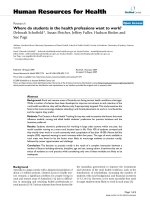Báo cáo sinh học: "Do unicolonial wood ants favor kin" docx
Bạn đang xem bản rút gọn của tài liệu. Xem và tải ngay bản đầy đủ của tài liệu tại đây (193.64 KB, 5 trang )
Minireview
DDoo uunniiccoolloonniiaall wwoooodd aannttss ffaavvoorr kkiinn??
Heikki Helanterä
†§
Addresses:
†
Department of Biological and Environmental Sciences, University of Helsinki, FI-00014 Helsinki, Finland.
§
Laboratory of
Apiculture and Social Insects, Department of Biological and Environmental Science, University of Sussex, Falmer, Brighton BN1 9QG, UK.
Correspondence: Heikki Helanterä. Email:
The supercolonies formed by so-called ‘unicolonial’ ant
species are huge cooperative groups - networks of inter-
connected nests that exchange individuals and share territory
peacefully over extensive areas [1]. In extreme cases, a whole
population can comprise a single supercolony; for example,
the largest supercolony discovered, the Mediterranean
Argentine ant supercolony, covers 6,000 kilometers of
Southern European coastline, and individuals accept each
other as colony-mates all the way from Italy to the Spanish
Atlantic coast [2]. A feature of supercolonies compared with
the more usual family-based colonies of social insects is the
free movement of individuals between nests, and the fact
that each nest contains several queens. Consequently, the
relatedness between nestmates approaches zero in the
Argentine ant and many other species, both invasive and
non-invasive [1]. In other words, individuals that share a
nest are no more similar genetically than would be
individuals chosen at random from the whole population.
AAnntt ssuuppeerrccoolloonniieess,, aa ddiilleemmmmaa ffoorr ssoocciiaall eevvoolluuttiioonnaarryy
tthheeoorryy
The evolution and persistence of unicoloniality poses a
dilemma for the widely accepted theory of kin selection as
an explanation for social evolution [1]. In all colonial
insects, including the unicolonial ants, the success of the
colony depends on so-called ‘altruistic’ behavior of non-
reproductive individuals - the workers - who build the nest,
collect food for the sexually reproducing queen and care for
the larvae (brood rearing) without any apparent benefit to
themselves in terms of maximizing their own reproduction,
their ‘fitness’. Kin selection theory proposes that such
altruism can evolve and persist if the altruists, such as the ant
workers, direct help only to individuals that are genetically
related to them. In family-based social insect colonies, which
usually have a single queen per colony, this will be their
mother queen and her brood. So, even though the workers
do not reproduce, their cooperative altruistic behavior
increases the chance that genes identical to their own will be
transmitted to the next generation; in other words, altruism
increases the ‘inclusive fitness’ of the individual worker - the
overall reproductive fitness of itself and its close relatives. In
such situations, production of both queens and workers, in
addition to males, is in the interest of the workers, queens,
and the developing larvae.
By this logic, altruism should not persist in a supercolony,
where the receivers of help - the nestmate queens - may be
AAbbssttrraacctt
Vast supercolonies of interconnected nests formed by unicolonial ant species are the largest
cooperative groups of animals known. Research published recently in
BMC Evolutionary
Biology
reveals that a supercolony can be more genetically structured than previously
thought, comprising several extended families. Surprisingly, the families coexist peacefully,
even though they seem to recognize each other as non-kin.
Journal of Biology
2009,
88::
56
Published: 18 June 2009
Journal of Biology
2009,
88::
56 (doi:10.1186/jbiol154)
The electronic version of this article is the complete one and can be
found online at />© 2009 BioMed Central Ltd
no more closely related to the workers in that nest than they
are to the rest of the supercolony. One might expect a
complete breakdown of co-operation in such circumstances,
with individuals behaving antagonistically towards non-
relatives, and natural selection no longer favoring worker
traits. Furthermore, in the absence of genetic relatedness,
‘selfish’ queens could maximize their fitness by producing
larvae that develop into females and males rather than
workers - in which case the supercolony, and the trait of
unicoloniality, would eventually die out [1].
But unicoloniality seems to be going strong, and not only in
invasive species. The paradox has been investigated by
Laurent Keller and colleagues in a series of papers on native
European wood ants of the genus Formica [3-6]. In their
most recent paper, published in BMC Evolutionary Biology
(Holzer et al. [3]), Keller and colleagues have looked more
closely at the genetic structure of supercolonies of the wood
ant Formica paralugubris. They find that supercolonies that
appear to behave as single units in fact harbor genetic sub-
structure and consist of several extended families living side
by side. Such structuring may help to explain the evolu-
tionary maintenance of unicoloniality [1,3], while the
peaceful coexistence of potentially competing families can
also teach us lessons about behavioral adaptations.
Even if supercolonies are problematic for kin selection
theory when they have grown to cover whole populations,
the behavioral rules that underlie their development can be
understood through inclusive fitness principles [1]. A super-
colony starts from a family group that extends its network of
nests and retains more and more queens (Figure 1),
competing against other such colonies. This is often a
successful strategy for monopolizing resources over a large
area, and can be favored by kin selection. But when this
successful family-based strategy continues for a long time
and the colony grows larger and larger, it paradoxically
dilutes the relatedness between individuals and eventually
leads to a situation where individual workers may no longer
be helping kin. Worker behavior is no longer favored by
selection, but because workers lack the means to assess the
decline in relatedness they continue to behave according to
the previously successful rules. Formation of supercolonies
with extremely low relatedness is especially easy for foreign
invasive species, whose colonies grow unhindered by
conspecific competitors and native parasites, and can extend
56.2
Journal of Biology
2009, Volume 8, Article 56 Helantera />Journal of Biology
2009,
88::
56
FFiigguurree 11
A hypothetical scheme of the life of a supercolony. In a young colony, relatedness between individuals is high as a result of the small number of
founder queens. Relatedness decreases as the colony grows and expands. But even if relatedness between individuals who do not behave aggressively
to each other drops to zero, relatedness to individuals who benefit from worker altruism remains above zero. Factors that increase relatedness
between individuals in altruistic interactions include: limited dispersal of sexuals, context-specific discrimination and variation in kin structures over
worker life-time.
Colony founding by
a small number of
queens
Recruitment of more
queens
Expansion of colony
through new nest
fornation
Relatedness
Time
Factors that affect
relatedness as
colony expands
Worker relatedness towards individuals
accepted in encounters between workers
Worker relatedness towards individuals
who benefit from altruism
Acceptance of outside individuals
from neighboring supercolonies
over hundreds of square kilometers. But in evolutionary
terms, supercolonies are thought to be evolutionary dead-
ends as the link between genetic relatedness and behavior
has been lost [1].
AArree ssuuppeerrccoolloonniiaall wwoooodd aannttss iinnddiissccrriimmiinnaattee
ccooooppeerraattoorrss??
In contrast to the Argentine ant, supercolonies of indige-
nous European ants, such as certain species of Formica wood
ants, are found in stable habitats such as boreal or alpine
forests and are non-invasive. But like their invasive counter-
parts, these supercolonies cover large areas, and workers
from distant parts of the supercolony behave unaggres-
sively, like nestmates, towards each other [4]. Holzer et al.
[3] made a detailed genetic and behavioral study of three
F. paralugubris supercolonies in the Swiss Jura mountains,
which revealed that the supercolonies are not as genetically
heterogeneous as expected, but consist of cryptic genetically
related clusters of nests [3]. These clusters define groups of
individuals that are genetically similar at a level comparable
to cousins, with the proportion of genes shared approxi-
mating to 0.125. These extended families are not sharply
delineated, but can exchange individuals and genes.
Holzer et al. [3] suggest that such family substructures might
enable workers to direct help to their relatives, and that this
might help to maintain the trait of unicoloniality, in line
with kin selection theory. However, the presence of
genetically differentiated subunits raises the question of
why there is no aggression within the supercolony, and why
the clusters keep exchanging individuals. In theory, workers
should exclude non-kin from sharing resources and
receiving altruistic help. In other supercolony-forming
species studied, within the supercolony aggression seems to
be minimized by workers being unable to recognize whether
an ant is close kin or not, but F. paralugubris workers behave
unaggressively in artificial bioassay encounters even though
they do seem able to recognize non-nestmates [4]. In con-
trast to most supercolonial ants, aggression is rare in F.
paralugubris, even towards individuals from other super-
colonies. The workers seem to treat most conspecifics
amicably, even if recognized as ‘outsiders’. Does this mean
that the potential inclusive fitness payoffs from the family
structuring are not in fact realized? Is it possible that the
peaceful strategy is itself favored by selection?
DDooeess llaacckk ooff ddiissccrriimmiinnaattiioonn ppaayy ooffff??
Whether lack of discrimination is adaptive depends on the
inclusive fitness costs of accepting strangers, compared with
the costs of aggression and of erroneously behaving
aggressively to group members (Figure 2). In F. paralugubris,
it seems that workers are prone to making mistakes in
recognition, probably because the large number of queens
in each family cluster increases genetic diversity within, and
decreases differentiation between, the clusters [3]. Thus,
aggression would sometimes mistakenly be directed against
relatives. This is the risk against which the benefits of
discrimination need to be weighed.
Indiscriminate acceptance is beneficial if the probability of
encountering unrelated individuals is low. This is likely in
F. paralugubris, because the population structure found by
Holzer et al. [3] suggests that movement between the
extended family clusters is limited. Of particular importance
in this regard, Keller and colleagues previously found that
the dispersal of queens in F. paralugubris is limited. This
would help to guarantee that brood care by the young
workers is directed towards relatives, even if the workers
later disperse. Workers in F. paralugubris increase their
inclusive fitness not by territorial aggression, but by rearing
related queens and males that disperse and compete with
queens and males from less related nests in other clusters
over recruitment as a breeder [5]. Holzer et al. [3] found
that especially males are prone to disperse and spread genes
across the clusters. In other words, relatedness will be above
zero in the brood-rearing context, which is most important
for inclusive fitness, even where territorial aggression is
lacking (Figure 1). The current study by Holzer et al. [3]
confirms previous findings by Keller and colleagues that
family structures are more obvious in queens and the brood
than in old workers in another supercolonial Formica ant [6].
This suggests that young workers take care of related broods,
even if they drift away from their relatives later in their lives.
Whether similar patterns of genetic structure and behavior
also occur in invasive supercolonies remains to be seen.
IIss llaacckk ooff ddiissccrriimmiinnaattiioonn mmoorree aappppaarreenntt
tthhaann rreeaall??
It is also worth noting that acceptance of non-kin in the
context of artificial aggression bioassays does not necessarily
mean that they are always accepted in natural contexts more
directly connected to inclusive fitness. Favoring individuals
that are likely to be relatives is adaptive only in contexts
where the inclusive fitness benefits of discrimination are
large. If competition for breeding places occurs mainly by
the recruitment of sexuals into the breeding population,
workers should be most prone to discriminate in contexts
more directly linked to their inclusive fitness, such as
behavior towards queens and males, and brood care [7,8].
Thus, worker ants in Formica supercolonies might be able to
direct the benefits of brood care mainly to the ‘right’
individuals as dictated by kin selection theory. The other
/>Journal of Biology
2009, Volume 8, Article 56 Helantera 56.3
Journal of Biology
2009,
88::
56
side of the non-aggression coin is whether it is harmful to
the rearing of related reproductives to allow strangers into
the territory. As long as this does not harm the production
of reproductives in your own nest, the risk of aggression is
perhaps not worth taking. This might be the case when
resources are abundant and the benefits of territorial
defense are subsequently small. Wood ants tend aphids, a
resource that thrives when ants are abundant, so resource
limitation may not be too severe in their case [3]. It will be
very interesting to see whether the putative family clusters
in wood ants also correspond to foraging areas and the
flow of resources, and whether ants are more prone to
discrimination at food sources, especially when resources
are scarce. Study of nutrient flow within a supercolony of
the Argentine ant has also shown that a seemingly
uniform supercolony might actually consist of separate
nest networks across which food resources are not shared
[9]. Ideally, relatedness should be measured at the level of
such functional units, in both native and invasive
supercolonies.
IIss tthheerree rreeaallllyy aa ddiilleemmmmaa??
The problem of indiscriminate altruism demonstrates how
complicated assessing the adaptive benefits of a behavioral
strategy can be. In particular, we need to consider all the
contexts in which a behavioral rule is applied. The ability to
readily recognize and respond to environmental informa-
tion is an important constraint on adaptation [10], and
organisms are not always able to adjust their behavior to
make an optimal response to a given situation. Instead, they
might need to rely on rules that work on average. In the case
of ant workers in a supercolony, the payoffs of behavioral
rules need to be assessed across all the contexts in which
they are used, over seasons, over the lifetime of the workers,
but also over the lifetime of the supercolony.
There may be cases where workers in a supercolony seem to
be in a dilemma. They are obeying the behavioral rules that
made their family big and strong, but this has brought them
to a situation where the rules no longer pay off. But this is
only a dilemma for evolutionary theory if we assume that
adaptation must always be perfect. The dilemma disappears
if we consider the rules underlying the behavior. Even if the
rules seem maladaptive in some cases, the evolutionary
benefits may have already been reaped in another.
AAcckknnoowwlleeddggeemmeennttss
I thank Joan Strassmann, Dave Queller, Jes S Pedersen and Tobias Uller
for inspiring discussions on unicoloniality, and Tobias Uller for com-
ments on the manuscript as well.
RReeffeerreenncceess
1. Helanterä H, Strassmann JE, Carrillo J, Queller DC:
UUnniiccoolloonniiaall
aannttss:: wwhheerree ddoo tthheeyy ccoommee ffrroomm,, wwhhaatt aarree tthheeyy,, aanndd wwhheerree aarree
tthheeyy ggooiinngg??
Trends Ecol Evol
2009,
2244::
341-349.
56.4
Journal of Biology
2009, Volume 8, Article 56 Helantera />Journal of Biology
2009,
88::
56
FFiigguurree 22
Factors that select for or against indiscriminate acceptance in social insects.
Withholding aggression favored if:
- most individuals encountered are relatives
- difficult to tell apart kin and non-kin; that is, errors likely
- accepting non-kin is not going to harm kin much
- the kin that may be harmed is not very close kin
- aggression costly
Aggression favored if:
- most individuals encountered are non-relatives
- easy to tell apart kin and non-kin; that is, errors rare
- accepting non-kin is going to harm kin
- the kin harmed is close kin
- aggression cheap
2. Giraud T, Pedersen JS, Keller L:
EEvvoolluuttiioonn ooff ssuuppeerrccoolloonniieess:: tthhee
AArrggeennttiinnee aannttss ooff ssoouutthheerrnn EEuurrooppee
Proc Natl Acad Sci USA
2002,
9999::
6075-6079.
3. Holzer B, Keller L, Chapuisat M:
GGeenneettiicc cclluusstteerrss aanndd sseexx bbiiaasseedd
ggeennee ffllooww iinn aa uunniiccoolloonniiaall
FFoorrmmiiccaa
aanntt
BMC Evol Biol
2009,
99::
69.
4. Holzer B, Chapuisat M, Kremer N, Finet C, Keller L:
UUnniiccoolloonniiaall
iittyy,, rreeccooggnniittiioonn aanndd ggeenneettiicc ddiiffffeerreennttiiaattiioonn iinn aa nnaattiivvee
FFoorrmmiiccaa
aanntt
J
Evol Biol
2006,
1199::
2031-2039.
5. Lehmann L, Ravigne V, Keller L:
PPooppuullaattiioonn vviissccoossiittyy ccaann pprroommoottee
tthhee eevvoolluuttiioonn ooff aallttrruuiissttiicc sstteerriillee hheellppeerrss aanndd eeuussoocciiaalliittyy
Proc R
Soc Biol Sci Ser B
2008,
227755::
1887-1895.
6. Kummerli R, Keller L:
CCoonnttrraassttiinngg ppooppuullaattiioonn ggeenneettiicc ssttrruuccttuurree ffoorr
wwoorrkkeerrss aanndd qquueeeennss iinn tthhee ppuuttaattiivveellyy uunniiccoolloonniiaall aanntt
FFoorrmmiiccaa
eexxsseeccttaa
Mol Ecol
2007,
1166::
4493-4503.
7. Vasquez GM, Silverman J:
QQuueeeenn aacccceeppttaannccee aanndd tthhee ccoommpplleexxiittyy ooff
nneessttmmaattee ddiissccrriimmiinnaattiioonn iinn tthhee AArrggeennttiinnee aanntt
Behav Ecol Sociobiol
2008,
6622::
537-548.
8. Holzer B, Chapuisat M, Keller L:
FFoorreeiiggnn aanntt qquueeeennss aarree aacccceepptteedd
bbuutt pprroodduuccee ffeewweerr ooffffsspprriinngg
Oecologia
2008,
115577::
717-723.
9. Heller NE, Ingram KK, Gordon DM:
NNeesstt ccoonnnneeccttiivviittyy aanndd ccoolloonnyy
ssttrruuccttuurree iinn uunniiccoolloonniiaall AArrggeennttiinnee aannttss
Insectes Soc
2008,
5555::
397-
403 .
10. West SA, Sheldon BC:
CCoonnssttrraaiinnttss iinn tthhee eevvoolluuttiioonn ooff sseexx rraattiioo
aaddjjuussttmmeenntt
Science
2002,
229955::
1685-1688.
/>Journal of Biology
2009, Volume 8, Article 56 Helantera 56.5
Journal of Biology
2009,
88::
56
